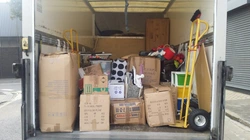Heavy Lifting Hacks for Those Working Alone
Are you an independent worker, solo renovator, or DIY enthusiast who frequently faces the challenge of lifting, moving, or carrying awkward and heavy objects without help? Heavy lifting when working alone can be daunting, but with the right strategies and tools, it's entirely manageable--and much safer. This comprehensive guide shares invaluable heavy lifting hacks for those working alone, ensuring you move hefty objects efficiently with minimal risk.

The Importance of Safe Solo Lifting
Every year, thousands of injuries result from improper lifting techniques. Without co-workers or friends to lend a hand, lifting alone increases your risk of strain, sprain, or worse. That's why knowing the best solo heavy lifting tips and proven safety methods isn't just helpful--it's essential!
- Statistics show that back injuries are among the most common musculoskeletal disorders caused by single-person lifting.
- Almost 80% of adults experience back pain at some point, often due to lifting incorrectly.
- Proper planning and technique can dramatically reduce the risk of injury.
Preparation: The Key to Success When Lifting Heavy Items Alone
1. Plan Ahead--Never Rush the Process
Preparation makes the whole process smoother and safer.
- Measure doorways, corridors, and the destination space before lifting.
- Clear your path of obstacles to avoid tripping or sudden stops.
- Wear proper clothing and footwear--closed-toed shoes with non-slip soles are a must.
2. Assess the Load: Can You Really Lift It Alone?
If the object is heavier than what you can reasonably handle, do not attempt to lift it alone. Get assistance or use mechanical aids.
- Know your physical limitations--most experts recommend not regularly lifting more than 25-50lbs by yourself, depending on your fitness and frame.
- Test the object's weight with a gentle push or lift from one corner.
- Check for shifting contents (for example, drawers or tools inside), which can make the load unpredictable.
Heavy Lifting Hacks for Solo Workers
1. Use Leverage, Not Pure Strength
A critical principle in solo heavy lifting is to work smarter, not harder.
- Utilize a lever: Slip a long, strong object (like a crowbar or thick broom handle) under a heavy item to lift one side enough to slide a dolly or pads underneath.
- Create makeshift rollers: Place sturdy pipes or dowels under large, flat items (like furniture or appliances) to roll them across the floor.
- If moving across carpet or grass, place something rigid and smooth (like a piece of plywood) underneath the item first.
2. Leverage Heavy Lifting Tools and Devices
Innovative lifting equipment has made working solo much easier. Consider investing in these must-haves:
- Furniture dolly: A platform with wheels that supports heavy loads and lets you roll them effortlessly.
- Lifting straps and harnesses: These distribute weight across stronger leg and shoulder muscles, allowing you to lift with better posture and less strain.
- Hand trucks (dollies): Essential for moving boxes, appliances, and even some furniture.
- Forearm forklifts: Simple straps that loop under the object and over your forearms, magnifying your lifting strength and leverage.
- Glides and sliders: Soft but strong pads placed under furniture feet or appliance corners to "slide" heavy objects with ease, protecting floors.
3. Break It Down--When Possible
If you can disassemble or reduce the weight of the object, do so.
- Remove drawers, shelves, or doors from furniture before moving.
- Take off detachable parts, like table legs or appliance doors.
- For machines or large storage units, empty their contents first.
4. Use Proper Lifting Technique
This cannot be emphasized enough: Never lift with your back!
- Squat down--bend at the hips and knees, not your waist.
- Keep the item as close to your body as possible.
- Lift with your legs, engaging your core for stability.
- Never twist your torso--if you need to change direction, move your feet first.
- If possible, keep your head up, looking forward, not down.
5. Slide, Don't Lift
Whenever possible, slide heavy objects instead of lifting them.
- Use felt pads, plastic sliders, or even a towel under the object.
- If the item is too heavy for even that, try a "walking" technique: lift one side slightly and move it forward, then the other.
6. Utilize Inclined Planes and Ramps
Getting heavy items up stairs or over curbs? Make your own ramp!
- A sturdy plank or purpose-built ramp can transform a vertical lift into a manageable push or roll.
- When using a dolly, make sure the ramp is securely anchored and strong enough to hold both you and your load.
7. Keep a First Aid Kit and Phone Handy
Always be prepared for unexpected injuries--scrapes, pinched fingers, or worse. If you work alone regularly, keep a phone on you or nearby in case of emergencies.
Common Mistakes When Lifting Heavy Loads Solo
- Trying to rush--moving too quickly is a recipe for accidents.
- Failing to check for hidden obstacles, like rugs, cords, or uneven surfaces.
- Wearing improper footwear or loose clothing that can snag or cause slipping.
- Overestimating personal strength--never hesitate to ask for help when needed.
- Twisting the back and not keeping the load close to your body.
Pro-Tips for Challenging Heavy Lifts
1. Protect Your Floors and Yourself
- Lay down moving blankets, cardboard, or plywood to avoid scratches or gouges.
- Wear gloves for better grip and to protect against sharp corners.
2. Use Gravity to Your Advantage
- If you must set an object down, lower one side first, then the other, controlling its descent.
- When moving downhill, move backward and keep the object in front of you, so you can guide it with gravity (but never let it "run away").
3. Rest as Needed
- Take short breaks between lifts, especially for larger moves.
- Hydrate often and don't overexert your muscles.
4. Use Mindful Breathing
- Breathe steadily--never hold your breath during the lift.
- Exhale as you lift, inhale as you prepare.
Special Situations and How to Handle Them
Getting Appliances Up or Down Stairs Alone
- Use an appliance dolly with straps and stair-sliding wheels if possible.
- If not, create a ramp with a strong board and slide the appliance carefully, using padding to prevent damage.
- Go slowly! Rest after each step, and always keep the load balanced and under control.
Moving Large Furniture Through Tight Spaces
- Measure all spaces in advance; remove any protruding handles or legs from the furniture.
- Wrap items in blankets to prevent nicks and scratches to both your item and doorframes.
- If stuck, try standing the furniture on its end and rotating slowly.
Ergonomics: Protecting Your Back and Body
- Regularly strengthen your core muscles with exercise; a strong core protects your spine during lifts.
- Stretch before and after heavy lifting to prevent stiffness or cramps.
- Practice good posture in everyday life to build body awareness.
Note: If you regularly need to lift heavy objects, consider professional training in ergonomics or safe lifting techniques. Many workplaces offer these as part of their health and safety programs.
Must-Have Tools for Solo Heavy Lifters
- Shoulder harnesses (like the "Forearm Forklift") for distributing weight.
- Adjustable moving straps for bulky but lighter items.
- Heavy-duty work gloves with grippy palms.
- Collapsible hand truck, easy to store or transport.
- Mover's blankets and corner protectors to shield both your home and your possessions.
- Anti-fatigue mats if working long hours on concrete or hard surfaces.

Frequently Asked Questions for Those Lifting Heavy Things Alone
-
Q: What if I drop a heavy object while moving it solo?
A: Let the object fall rather than risk your body--possessions can be replaced; your health cannot. Move slowly and keep toes and fingers out of harm's way. -
Q: Is there a safe maximum weight for solo lifting?
A: Most safety standards recommend adult men lift no more than 50lbs and women 35lbs. For anything heavier, use mechanical aids or get help. -
Q: Can lifting alone ever be as safe as having two people?
A: With the right tools and techniques (lifting aids, proper planning, body awareness), solo lifting can be safe, but team lifting is ideal for truly heavy or unwieldy items. -
Q: How do I move a heavy object with stairs and no elevator?
A: Use a stair-climbing dolly or create a sturdy ramp. Go slowly, keeping the load under tight control.
Final Thoughts: Work Smarter with Heavy Lifting Hacks
Mastering heavy lifting hacks for those working alone is all about combining smart preparation, ergonomic technique, protective gear, and the right lifting equipment. Whether you're a solo contractor, a homeowner handling a big project, or an independent worker in a warehouse, these hacks will make every heavy move easier and much safer. Remember, when working alone, nothing is more important than your safety. Invest in the right tools, practice your technique, and never hesitate to seek help when a load is beyond your comfortable ability.
Ready to transform your moving and lifting experience? Use these heavy lifting hacks to become more efficient, protect your body, and accomplish impressive feats even when it's just you on the job!


